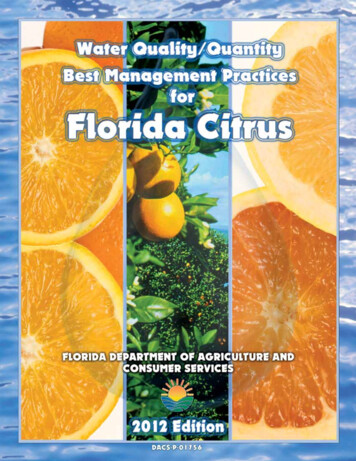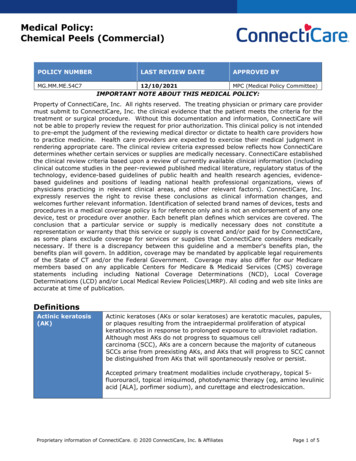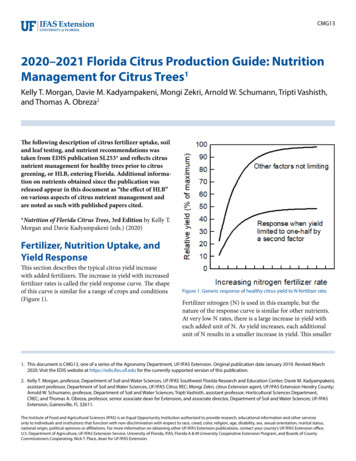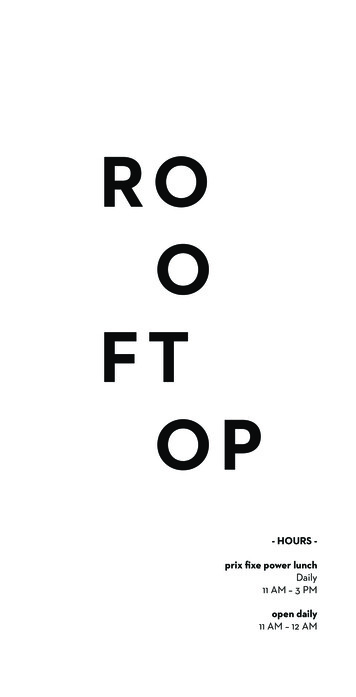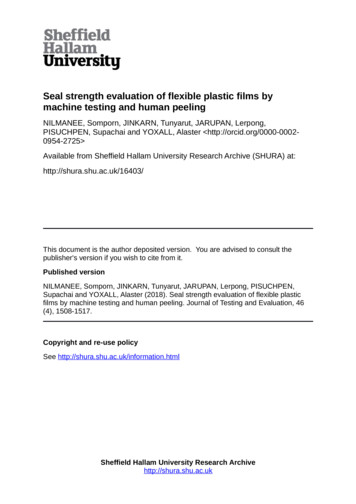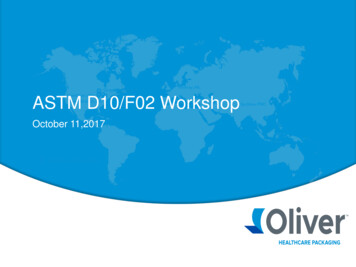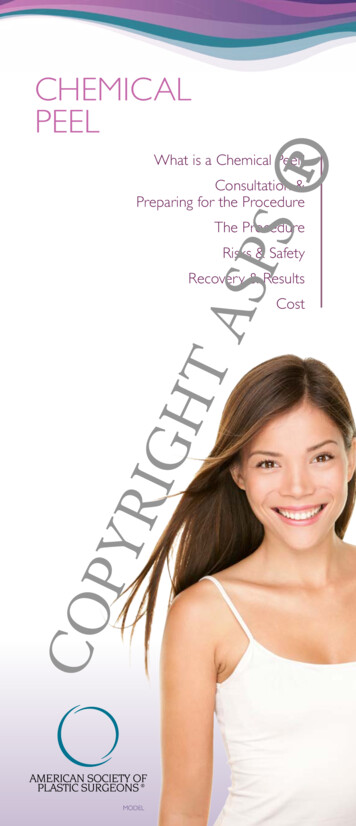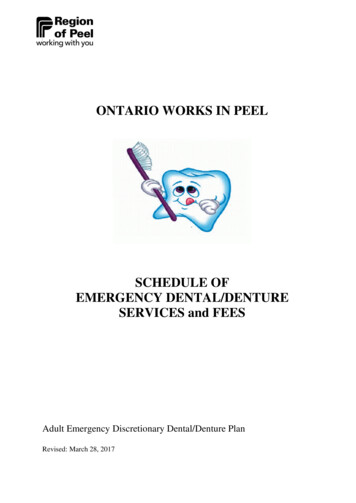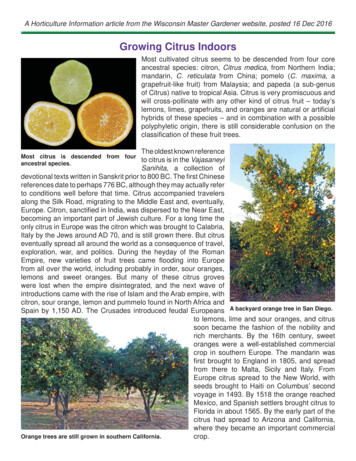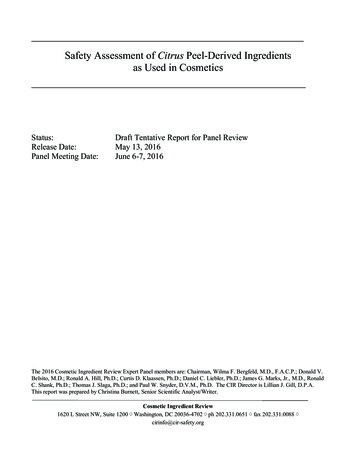
Transcription
Safety Assessment of Citrus Peel-Derived Ingredientsas Used in CosmeticsStatus:Release Date:Panel Meeting Date:Draft Tentative Report for Panel ReviewMay 13, 2016June 6-7, 2016The 2016 Cosmetic Ingredient Review Expert Panel members are: Chairman, Wilma F. Bergfeld, M.D., F.A.C.P.; Donald V.Belsito, M.D.; Ronald A. Hill, Ph.D.; Curtis D. Klaassen, Ph.D.; Daniel C. Liebler, Ph.D.; James G. Marks, Jr., M.D., RonaldC. Shank, Ph.D.; Thomas J. Slaga, Ph.D.; and Paul W. Snyder, D.V.M., Ph.D. The CIR Director is Lillian J. Gill, D.P.A.This report was prepared by Christina Burnett, Senior Scientific Analyst/Writer.Cosmetic Ingredient Review1620 L Street NW, Suite 1200 Washington, DC 20036-4702 ph 202.331.0651 fax 202.331.0088 cirinfo@cir-safety.org
Commitment & Credibility since 1976MemorandumTo:From:Date:Subject:CIR Expert Panel Members and LiaisonsChristina Burnett, Senior Scientific Writer/AnalystMay 13, 2016Draft Tentative Report of the Safety Assessment of Citrus Peel-Derived IngredientsEnclosed is the draft tentative report of the Safety Assessment of Citrus Peel-Derived Ingredients as Used in Cosmetics. (Itis identified as cpeels062016rep in the pdf document.)At the December 2015 meeting, the Panel issued an Insufficient Data Announcement for the 47 Citrus peel-derivedingredients described in the safety assessment. Data needs included: Method of manufacturingChemical composition and impuritiesIrritation and sensitization, especially human repeated insult patch tests (HRIPT) on Citrus Aurantium Dulcis (Orange)Peel Extract, Citrus Grandis (Grapefruit) Peel Extract, Citrus Limon (Lemon) Peel Extract, and Citrus Unshiu PeelExtract at maximum use concentrations or greaterSince the December meeting, unpublished data on the method of manufacturing and composition/impurities of CitrusAurantium Amara (Bitter Orange) Peel Extract, Citrus Reticulata (Tangerine) Peel Extract, and Citrus Unshiu Peel Extracthave been received as well as genotoxicity data on Citrus Reticulata (Tangerine) Peel Extract and dermal/ocular irritationand/or dermal sensitization data on Citrus Aurantium Amara (Bitter Orange) Peel Extract, Citrus Grandis (Grapefruit) PeelExtract, Citrus Limon (Lemon) Peel Extract, Citrus Reticulata (Tangerine) Peel Extract, and Citrus Unshiu Peel Extract. Inaddition, phototoxicity/photosensitization data on Citrus Aurantium Amara (Bitter Orange) Peel Extract and CitrusReticulata (Tangerine) Peel Extract were received. Composition data of the hexane extract of Citrus aurantifolia (lime)peel was found in the published literature. These data have been incorporated into the report and highlighted with brackets or highlighted in tables. No other requested data have been received or identified by CIR staff. Comments received fromthe Council have been considered. The comments and the unpublished data can be found in this report’s package(cpeels062016pcpc and cpeels062016data1-10, respectively).Both the VCRP and the concentration of use data have been updated for these ingredients. Currently, Citrus Limon(Lemon) Peel Extract has the most reported uses of the ingredients in this report in cosmetic products, with a total of 150;more than half of the uses are in rinse-off preparations (e.g. non-coloring hair conditioners, hair shampoos, and skincleansing preparations). Citrus Paradisi (Grapefruit) Peel Extract has the second greatest number of overall uses reported,with a total of 61; more than half of the uses are in skin care preparations. The results of the concentration of use surveyconducted in 2016 by the Council indicate Citrus Aurantium Dulcis (Orange) Peel Powder has the highest reportedmaximum concentration of use; it is used at up to 2% in skin cleansing preparations. The highest reported maximumconcentration of use in a leave-on product is 1.9% in a lipstick for Citrus Aurantium Dulcis (Orange) Peel Wax. Please notethat the data requested at the December 2015 meeting were based on the highest uses/concentrations reported at the timeand that the ingredients with the highest uses/concentrations may have changed since then. (Citrus Aurantium Amara(Bitter Orange) Peel Powder and Citrus Aurantium Dulcis (Orange) Peel Powder were both previously reported to be usedat up to 6% in skin cleansing preparations).The Panel should carefully consider and discuss the data presented in this report and issue a Tentative Report with a safe,safe with qualifications, or insufficient data conclusion.1620 L Street NW, Suite 1200, Washington, DC 20036(Main) 202-331-0651 (Fax) 202-331-0088(Email) cirinfo@cir-safety.org (Website) www.cir-safety.org
SAFETY ASSESSMENT FLOW CHARTINGREDIENT/FAMILY Citrus Peel-Derived IngredientsMEETING June 2016Public CommentCIRExpert PanelPriority ListINGREDIENTAt the Mar 2014 meeting, thePanel reviewed a report on 198citrus-derived ingredients, andsplit the report into sub-groups.This is the citrus peel-derivedsubgroup.PRIORITY LISTSLRDec 2013DRAFT REPORTDec 2015Draft Report60 day public comment periodTableTableIDA NoticeDec 18, 2015IDATRIDADRAFT TENTATIVEREPORTJune 2016Draft TRTableTableIssue TRTentative ReportDRAFT FINAL REPORTDraft FR60 day Public comment periodTableTablePUBLISHFinal ReportDifferent ConclusionIssueFRReport Status
Distributed for comment only -- do not cite or quoteCitrus Peel-Derived Ingredients HistoryDecember 2013 – Scientific Literature Review announced.March 2014 - The Panel tabled further discussion of 198 citrus-derived ingredients toallow CIR staff to reorganize the report and to obtain clarification from RIFM on thefunctions of some of the ingredients. These ingredients were presented in a single safetyassessment report addressing ingredients from all of the citrus plant species currentlyreported to be used in cosmetics in the International Cosmetic Ingredient Dictionary andHandbook. The Panel felt revising this report into smaller subgroups would be amanageable and meaningful alternative approach to assessing the safety of theseingredients. Based on the Panel’s recommendation of grouping the ingredients by plantparts according to greatest number of uses, the first assessment reviewed by the Panelwas citrus-derived peel oils, followed by citrus fruit-derived ingredients.September 2015 – The Panel reviewed the report strategy for the remaining citrusingredients. The Panel agreed that the remaining ingredients could be divided into 3reports: citrus flower- and leaf-derived ingredients, citrus peel-derived ingredients, andcitrus plant- and seed-derived ingredients. These reports can be reviewed concurrently.December 2015 - The CIR Expert Panel requested additional data to support the safety ofthe 47 Citrus peel-derived ingredients. The additional data needed are: Method of manufacturingChemical composition and impuritiesIrritation and sensitization, especially human repeated insult patch tests (HRIPT) oncitrus aurantium dulcis (orange) peel extract, citrus grandis (grapefruit) peel extract,citrus limon (lemon) peel extract, and citrus unshiu peel extract at maximum useconcentrations or greater.
Distributed for comment only -- do not cite or quoteCitrus Aurantifolia (Lime) Peel PowderXCitrus Aurantium Amara (Bitter Orange) PeelXCitrus Aurantium Amara (Bitter Orange) PeelExtractCitrus Aurantium Amara (Bitter Orange) PeelPowderCitrus Aurantium Amara (Bitter Orange) PeelWaxCitrus Aurantium Bergamia (Bergamot) PeelWaterXXXXXCitrus Aurantium Dulcis (Orange) Peel WaxXCitrus Aurantium Tachibana Peel ExtractCitrus Depressa Peel ExtractXCitrus Grandis (Grapefruit) Peel ExtractXCitrus Junos Peel ExtractXCitrus Limon (Lemon) PeelXCitrus Limon (Lemon) Peel PowderXCitrus Nobilis (Mandarin Orange) Peel ExtractXCitrus Reticulata (Tangerine) Peel ExtractXCitrus Unshiu Peel ExtractXXXXXXXXCitrus Jabara Peel ExtractXCitrus Junos Peel PowderXCitrus Limon (Lemon) Peel ExtractXCitrus Limon (Lemon) Peel WaxXCitrus Paradisi (Grapefruit) Peel ExtractXCitrus Tangerina (Tangerine) Peel ExtractXCitrus Unshiu Peel PowderXXXXXXXXXXXXXXXXCitrus Tachibana (Tachibana) Peel ExtractXorange peel (generic, not INCI ingredient)XXNO USES OR DATA WERE AVAILABLE FOR THE REMAINING CITRUS INGREDIENTS LISTED IN TABLE 1.“X” indicates that data were available in the category for that ingredient.Case StudiesIrritation/Sensitization- ClinicalIrritation/Sensitization- uritiesMethod ofManufacturingXXCitrus Aurantium Dulcis (Orange) Peel Powderlemon peel juiceXXXCitrus Medica Limonum (Lemon) Peel WaxXXXCitrus Aurantium Dulcis (Orange) Peel ExtractCitrus Aurantium Amara (Bitter Orange) PeelWax (not INCI ingredient)XPhototoxicityXOcular/MucosalCitrus Aurantifolia (Lime) Peel ExtractPhysical/ChemicalPropertiesIn-UseCitrus Peel-Derived Ingredients Data Profile – June 2016 – Writer, Christina Burnett
Distributed for comment only -- do not cite or quoteSearch Strategy for Citrus Peel-Derived Ingredients August 2014 – miscellaneous searches for additional data on constituentsScifinder – February 26, 2013o Search for INCI citrus ingredients w/ CAS No. – 99 hits, 10 orderedPubMed – March 5,2013o Search for “citrus cosmetics” – 65 hits, 1 orderedo Search for “citrus sensitization” – 36 hits, 8 orderedo Search for “citrus dermal” – 12 hits, 0 orderedo Search for “citrus phototoxicity” – 24 hits, 10 orderedSciFinder – Aug 19 2013o toxicity of citrus ingredients – 11 hits; 1 orderedo carcinogenicity of citrus – 466 hits; 8 orderedSciFinder – Aug 20, 2013o Phototoxicity of citrus – 47 hits; 21 orderedo Dermal effects of citrus – 51 hits; 1 new ref foundo Dermal absorption of citrus – 1 hit; not usefulo Constituents of citrus – 116 hits;o Citrus – Belsito, Marks, Bergfeld, Api, RIFM– 2 foundOrdered a few others; printed some directlyUpdated searches in November, 2013 – ordered an additional 4 referencesUpdated searches July 2015 with the term “citrus” – 1 new relevant reference found.Updated searches October 2015 with the term “citrus AND peel NOT oil”– 0 new relevant references found.Updated searches February-May 2016 with the term “citrus peel composition NOT oil” – 52 hits, 5 relevant referencesfound (many returns still were on peel oils).Online Info FDAo GRAS definitions Dr. Duke’s Phytochemical and Ethnobotanical Databaseso Due to volume of data, limited search to Citrus limon (Lemon), Citrus aurantifolia (Lime), Citrus paradisi (Grapefruit),Citrus sinensis (Sweet Orange), and Citrus aurantium (Bitter Orange)National Toxicology Program (NTP) o Bitter Orange Extract (mixture)SCCS/SCCP o Opinion on fragrance allergens in cosmetic productso Opinion on Furocoumarins in cosmetic productsSigma Aldrich o Citrus aurantiifolia (lime)o Citrus aurantium (bitter orange)o Citrus paradisi (grapefruit)o Citrus reticulata (tangerine)IFRA o 7-methoxycoumarino Standard for citrus oils and other furocoumarins containing essential oils. Ingredients include:
Distributed for comment only -- do not cite or quoteCitrus Peel-Derived IngredientsDecember 14-15, 2015Dr. Marks’ TeamDR. MARKS: Okay. Moving on to the next, the citrus peel.This is the first review of these 47 ingredients that include the peel, peel extract, powder, wax juice. Arethese ingredients okay, Ron, Ron, and Tom? Are there any ingredients that should be eliminated?DR. HILL: I'm fine with it.DR. SHANK: I'm fine with it. So the ingredients are okay. So what needs do we have for the peel-derivedingredients?DR. SHANK: Irritation and sensitization data.DR. MARKS: Yep, I agree.DR. SHANK: On all of the peels at maximum use concentration.DR. MARKS: Yeah. So what I did with that, Ron, is I took -- I looked at the uses and I picked the threewith the highest uses, which was the peel extract, or I should say -- let me see. The orange peel extract, andone at HRIPTs for that at 1.9 percent. That was its use concentration. The grapefruit peel extract, the.5percent, any unshiu shield peel extract at.94, they were the ones that had the highest uses. Any others, theconcentrations by and large were really low, like for the mandarin orange peel extract, there were 19 usesbut it was only being used at.03 percent. So I felt those three would give me enough information to be ableto feel comfortable with a group.DR. HILL: Number of uses or greatest concentration use?DR. MARKS: I took the highest uses and then the concentration corresponded with them. So the orangepeel extract at 54 uses at 1.9 percent. The grapefruit peel extract had 48 uses at.5 percent, and the unshiupeel extract had 40 uses at.98, and they were also the highest concentrations of use. So that's why I pickedthose three and would feel we could read across if they're okay. And I picked several differentcitrus -- what's unshiu, Christina, do you know?DR. HILL: I thought there was something on that in the species comparison.DR. MARKS: So, Ron, does that sound reasonable to you?DR. SHANK: Well, since lime was of interest before -MS. BURNETT: It's related to tangerine.DR. SHANK: You're going on the fact that the concentration of use is low?DR. MARKS: Yeah,.025 percent. That's why -DR. SHANK: In a leave-on.DR. MARKS: Yes.DR. SHANK: So if that's a leave-on in sunscreen or something -DR. MARKS: We're probably going to have that 5- MOC in the conclusion anyway.
Distributed for comment only -- do not cite or quoteDR. SHANK: Okay.DR. MARKS: I would think. I would think that conclusion is going to continue through once we -- we'realways going to be putting on their limit the 5-MOC to 15 parts per million.DR. SHANK: How many uses does the wax have? Not many, right?DR. MARKS: Four. The orange wax, or which wax?DR. HILL: Any wax.DR. SLAGA: Any wax.DR. MARKS: Four for the orange wax. Orange peel wax. And that was basically -MS. BURNETT: Five for the bitter orange peel wax.DR. MARKS: Yeah, so small numbers.MS. BURNETT: One for lemon -DR. SLAGA: Because we do have a little data on that. That's the only one.DR. MARKS: Right. Yeah, actually, I was -- at 100 percent that was okay for the orange peel wax andtheir irritation and sensitization.DR. SLAGA: You know, we had a pretty good composition of the waxes, too.DR. MARKS: Yeah. Do you think you could -- we couldn't extend that over -DR. SLAGA: I don't know how it could extrapolate it to the other ones -DR. MARKS: Yeah, exactly.DR. SLAGA: -- but we do have that.DR. MARKS: Yeah, I had that one as okay. I guess you could say -- I was thinking we would put aninsufficient data announcement and when we came to the conclusion eventually the wax will be safe. Ithink we can say that right now.DR. SLAGA: We can say it right now.DR. HILL: So you said the grapefruit peel extract was one of the ones you wanted to see?DR. MARKS: Yes.DR. HILL: Okay.MS. BURNETT: And lemon?DR. MARKS: Orange peel, grapefruit peel, and mshiu, if that's how you say it.DR. SHANK: Tangerine.DR. MARKS: Oh, tangerine. Okay, thank you.
Distributed for comment only -- do not cite or quoteMS. BURNETT: Lemon has the most uses at 171. PDF page 21.DR. MARKS: And what's the concentration of use?MS. BURNETT: .51 is the max. It's a rinse- off.DR. MARKS: So let's get lemon in here, too.MS. BURNETT: Let's do all of it.DR. HILL: I really wanted to see method of manufacture.DR. MARKS: Yeah, I had that up front in composition. We only had these for the orange peel wax.So the lemon was.5 you said?MS. BURNETT: .51.DR. MARKS: Lemon peel extract. Is that the one? 0.5 percent. Thanks, Christina.So, Tom, Rons, at this point, I like the idea of getting your method of manufacturing composition. Are wegoing to all the other tox, we're just going to say these are GRAS and we don't need any of them? And wesay that in the -- I should say Christina says it in the third paragraph of the introduction, thus, the systemictoxicity potential of citrus peel-derived in the gradiance via oral exposure is not addressed further in thisreport. The primary focus is the safety on topical exposure. And that GRAS -So presumably, I'll be seconding a motion with an insufficient data announcement tomorrow and method ofmanufacture composition of a number of these others, you'd like to see those. Does that seem reasonable?DR. SLAGA: Yeah.DR. SHANK: Methods of manufacture, in the report it suggests that orange peel juice of cosmetic gradewas not phototoxic but noncosmetic (inaudible) was phototoxic, so is there something in the manufacturerthat -- this stems from Table 11, page 26. Now, if we have the Latin name, that means it's cosmetic grade,and if it's just English, that's not -DR. ANSELL: I'm sorry, what table was it?DR. SHANK: This is Table 11, page 26.DR. MARKS: And cosmetic grade is non -DR. SHANK: Now, my understanding is if the ingredient has a Latin name, that's what's used incosmetics, and if it doesn't have a Latin name -DR. ANSELL: No, that's a naming convention for these cosmetics. It goes backwards.MS. BURNETT: So if the data came through the Council and we were told that it was for that specificentry that has the proper inking name, which is citrus aurantium dulcis orange peel wax. That was data thatwas collected. If it's a common name that was from the published literature of some university that didresearch on it and it's not.DR. SHANK: Not necessarily cosmetic ingredient.MS. BURNETT: It's not a cosmetic necessarily.DR. HILL: The second one in that table --
Distributed for comment only -- do not cite or quoteDR. SHANK: But there's a big difference in the response.DR. HILL: One of them is a peel wax. The other one is not. The one below it is -- it's an extract, alcoholextract. In one case the peel; another other case the mesocarp and a case of fruit. There were threedifferent extracts.DR. SHANK: And fruit of (inaudible) extract.MS. BURNETT: It's not written right but there are three different extracts, each of which is alcoholic. It'sjust not punctuated right is the better way to say it.DR. SHANK: Well, there are extracts and their direct application.MS. BURNETT: Okay, let's see. So it was both a peel and a peel extract.DR. HILL: Pure peel. How do you apply a peel, pure peel? How would you do that?DR. ANSELL: See, I think we could certainly ask the questions. This is the first time through but I thinkthe reading -- the correct reading from looking at the procedure would be sweet orange peel mesocarp orfruit alcohol extracts. And that they didn't peel the mesocarp or fruit applied directly or as an alcoholextract.DR. HILL: Okay. Okay, yes. I see it now.DR. ANSELL: And then they photo (inaudible) radiate it and they examined it one, two, three, and fourdays. And so a strong (inaudible) 48 hours post-radiation to a peel and peel extract, slight for pure peelextract.DR. HILL: See, this last one was why I thought there were three different preparations.DR. MARKS: Okay. So any other comments? So tomorrow presumably we're going to have a motionto -- that there will be an insufficient data announcement from the Belsito team, and we want method ofmanufacture and composition for as many ingredients as we can get.DR. SLAGA: Other than wax.DR. MARKS: Other than wax. We have the wax now. And then we would like to see the HRIPT for anumber of these ingredients, the orange peel extract, the grapefruit peel extract, the tangerine peel extract,and lemon peel extract, that their concentrations, the highest concentration of use in leave-ons and we'll gofrom there. Does that sound reasonable?DR. SLAGA: Good.DR. HILL: What I was going to ask about is Table is photosensitization and phototoxicity. Are we justassuming that 5-MOC covers it and there's nothing else that we have to concern ourselves with or how dowe -- I mean, maybe we can defer that question until tomorrow, but -DR. MARKS: Oh, I wouldn't defer it. I think if I understood it correctly, in all these citrus ingredientsthere's not 7-MOC.DR. HILL: No, I wasn't 100 percent crystal clear that 5-MOC was the only geraniol coumarin present inany of them at all. I just knew that was a significant one. And actually, I read about this yesterday. I haveno recollection what I read last evening about that, or Saturday evening. It all ran together.DR. MARKS: I think 5-MOC is --
Distributed for comment only -- do not cite or quoteDR. HILL: It's a good enough sentinel to be worried about. Okay.DR. MARKS: Exactly. Okay. Any other comments?DR. GILL: Just for clarification, I thought I heard Dr. Shank read someplace in the report where itmentioned a cosmetic grade ingredient, and I just wanted to clarify because I think we had a question fromthe industry, maybe or someone that says -DR. HILL: There's no such thing.DR. GILL: -- there's no such thing as a cosmetic group. It's an ingredient used in cosmetics. So if it's inhere, we'll find it and replace that.DR. ANSELL: Okay. I'll (inaudible).DR. GILL: Okay.DR. HILL: Yes, because in that previous report we were talking about the difference between aningredient name versus the Latin name of the plant that was used.DR. MARKS: And then, probably one other thing, Christina, to clarify. Let me see. I don't have the page.It's got to be -- I'm sensing it's -- it was a reference to the paper reporting Danish occupational foodhandlers.MS. BURNETT: Uh-huh. Under occupational -DR. HILL: I was going to ask about that, too. That's page 12.DR. MARKS: Yeah, page 12. As it turn -- when you look at that report, they -- those were positive pricktests. Not patch tests so I would clarify that that you don't get confused that this is delay-typehypersensitivity reaction.MS. BURNETT: A prick test.DR. MARKS: They were prick tests and then, the other thing is they related it back to this NDF proteincontact dermatitis but they didn't mention any of the workers having respiratory or other symptoms of ananaphylactic type reaction. So I think note it in there but make sure it's reference to prick test and no othermention of systemic effects.And I don't know how it would be related as a cosmetic ingredient because one, perhaps the concentrationbut also there aren't reports of contact urticaria to these ingredients. And that's how it would manifest in atopical preparation. Okay.DR. HILL: So are you suggesting that we'll further mine that reference and make sure that a little -DR. MARKS: It's clarified.DR. HILL: -- additional language clarifies what we're dealing with here?DR. MARKS: Yes.DR. HILL: All right, great.DR. MARKS: Yes, it wasn't like the experience in Japan where they having anaphylactic reactions withtopical exposure. Okay. And I have that noted in mine here. Okay, any other comments? Okay.
Distributed for comment only -- do not cite or quoteDr. Belsito’s TeamDR. BELSITO: Okay. So then, we move to now, the citrus-peel derived ingredients, and this is the firsttime we are looking at these. And there was an issue about the actual number of ingredients to be clarifiedbetween the INCI dictionary and the VCRP database, and in the meantime though we've included those thataren't in the INCI dictionary, but are in the VCRP database in this report as I recall. Is that correct?MS. BURNETT: They are at least in the use table.DR. BELSITO: They are in the use table?MS. BURNETT: Mm-hmm.DR. BELSITO: So then how do we deal with that, Bart?DR. HELDRETH: Until we are given some sort of clarification that the different names overlap and havethe same ingredient, and adjust them as -- each as ingredient. I think there are some issues with, you know,one of the suppliers entering information that the VCRP database they may not have the option to enter theINCI name, so they have to pick something else that may not line up, or easily be coordinated with theINCI name.So, we are left wondering, you know, which ingredient does this specifically apply to? So, until we havesome clarification on that, I think it's best to look at these as individual ingredients.DR. BELSITO: But do we have the ability to add an ingredient as a cosmetic ingredient if it doesn't existin the dictionary? And which is essentially what we'll be doing, right, if we put this in the use table?MS. BURNETT: We have several different reports that have the same issue.DR. BELSITO: Really?DR. HELDRETH: I mean, we are saying we know that they are in use. If it's recorded in the VCRPdatabase, where we are making the assumption that these ingredients are in use now, but possibly thesupplier will use the correct INCI name on their label, and kind of really violated the codification of theINCI names, but at this time we may not have specific information that tells us which VCRP name windsup with which INCI name.MS. BURNETT: It's not this report but one of the other citrus reports, the whole plant report where we seea huge discrepancy where something was reported in the VCRP was 100-some uses but it's not in thedictionary, and we don't know what it is exactly, but it has the most uses.DR. BELSITO: I remember it coming up several times in these reports, and so just, I'm trying to clarify,how does this happen? So, if you go into the VCRP, is it just a scroll down, and you have to choose aspecific one, and the VCRP has the wrong name, or these people are just typing in the name that they thinkthe product is?DR. HELDRETH: Maybe a submitter could give us the information because neither one of us haveactually done a submission, but I know -DR. EISENMANN: We've heard from our members when they go to the VCRP, sometimes they don'thave the choice of selecting the INCI name. And this is coming up with apple. So, I think FDA hasdecided at some point that they are going to use their accepted -DR. LANGE: The agriculture -DR. EISENMANN: Right. The Agricultural Research Services, except that genus species name for appleis Malus domestica. And so if you want to register a product containing apple, you have to select malus
Distributed for comment only -- do not cite or quotedomestica, but what they are putting on the label, and I get this -- I got some responses, and the lastconcentration of use survey, they came back and said, Malus domesitica. And I asked, are you putting thaton the label? And they said, no, we are using Pyrus Malus, we are using the INCI name on the label.But FDA has been pushing them for it. So, I'm not sure why that's happening, but that's what our membersare reporting, that was a -- it's a botanical issue that FDA is not always accepting the INCI name to registera product. They are rejecting some product registrations when they put it. So, in order to get the productregistered they have to go to whatever genus species name FDA is using for that species.DR. BELSITO: So, it is sort of like a dropdown tab where you -DR. EISENMANN: That's what I understand, yes.DR. SNYDER: So, kind of a naïve question. So how often is the dictionary updated, and then what drivesupdating the dictionary?DR. LANGE: The INCI or the VCRP?DR. SNYDER: INCI dictionary.DR. EISENMANN: They try not to change names on the INCI dictionary, but it's up -- I mean, we do anightly update, so any little change can get updated.DR. SNYDER: Okay. So it is.DR. EISENMANN: So, it's updated frequently.DR. SNYDER: Frequently. Okay, thank you.DR. HELDRETH: I think the one thing to remember is the codification is for the INCI name, so even if theVCRP is requiring a supplier under a certain name, the supplier has to use the INCI name. So it's not amatter of the dictionary not getting updated to the correct name, it's a matter of the supplier can't pick theINCI name when they are putting their registration in. So it's really not an update of the dictionary issue.It's this disparity between the nomenclature, between VCRP and INCI.DR. SNYDER: But there's no mechanism on the survey for them to indicate that the choice they want touse is not found, and they are just allocation or -DR. HELDRETH: I mean, they could make that known to the industry when they do a survey, but itdoesn't show up in the database stuff we get from VCRP each year.DR. LANGE: My understanding is, in VCRP, if they don't choose one of the given names the applicationis rejected.MS. BURNETT: So I suppose if the survey came back, the use survey, if the company knows that it'sinputted in the VCRP as this other name, it will be helpful for us, so we would know and not count it as aseparate entry in the use table, because that's how it is now, as we don't know how to rectify that, and wejust put them in.DR. EISENMANN: It's unlikely to happen. And likely there's probably different person is doing mysurvey versus who is doing the VCRP.MS. BURNETT: Yes. I understand it's not likely -- We try to reflect it where we could figure it out, but insome cases we couldn't figure out what it was.
Distributed for comment only -- do not cite or quoteDR. BELSITO: Okay. So, another layer of confusion for the botanicals, if we don't have enough -- Sowith these peel-derived ingredients, I thought we were really lacking a lot with manufacturing constituents,impurities, sensitization and irritation of the extract, powder and water. And this is one where I wonderedif we had grouped correctly, because we are having waxes and oils, and water and powder from the peels,and it's the peel that's the real issue.I mean that's where the psoralens are, and I would think that the constituents of a wax and oil are going tobe extremely different than the constituents of water. And a powder, I'm presuming is going to beeverything that's in the peel so I think this is the report where I really begin thinking, did we lump thesecorrectly, and I'm just throwing that out as a comment, because we don't really know what that means. Wehave an idea, the overall, what's in a peel, but do we know what's in a peel wax and a peel oil and in a peelpowder? And I didn't think so. So, I had problems with this report.DR. LIEBLER: I think in one of the other reports, we have some flow chart or scheme illustrating theproduction of the different types of components. Is it -- I can't remember which one it is, I just scrolleddown through this one, and I don't see a figure at the end. Do you remember, Christina?MS. BURNETT: It was
more than half of the uses are in rinse-off preparations (e.g. non-coloring hair conditioners, hair shampoos, and skin cleansing preparations). Citrus Paradisi (Grapefruit) Peel Extract has the second greatest number of overall uses reported, with a total of 61; more than half of the uses are in skin care preparations.
